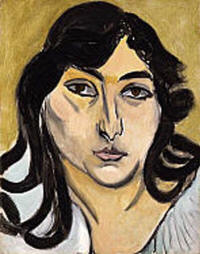Previous: Damien Hirst at the Norton (22)
Matisse at the Norton
Post #742 • March 1, 2006, 9:04 AM • 2 Comments
Matisse in Transition: Around Laurette gathers paintings done during the same three-year period as the Norton's Laurette work below.

Laurette with Long Locks, 1916. Oil on wood, 13 7/8 by 10 1/2 inches. Norton Museum of Art, bequest of R.H. Norton, 53.124 © 2005 Succession H. Matisse, Paris / Artists Rights Society (ARS), New York
To my surprise, I found the exhibition underwhelming. From 1916 to 1919, Matisse was pushing hard to develop a figure limned with a heavy, dark outline. (I've tried to do it myself, and although I'm no Matisse, I've learned that it's hard to throw a heavy line around a figure in a painting and not to make it look idiotic. Using intense colors at the same time, as Matisse did later, only exacerbates the difficulty of the problem.) The late Teens saw him gearing up towards his extraordinary Nice paintings, in which this line takes on a sweetness that hardly seems possible given its weight. He produced more than a few major masterpieces during that time, notably The Music Lesson, which I saw last month at the Barnes.
Matisse in Transition shows the artist repeatedly turning to a favorite model, Laurette, and Matisse's daughter, Marguerite, as he tries to advance his work. Hard, crescent-shaped areas of modelling that Picasso could have pulled off in his sleep turned awkward and alien in Matisse's hand. The distortions have all the signs of something that looked good in a drawing but refused to translate into color. Many of the other works in the show exhibit the same unease of handling - unresponsive lines around forms, distorting them into caricatures. His Cubist assaults on the figure seem less Bruce Lee and more Jackie Chan - they have an undercurrent of playfulness that characterizes the artist perfectly but don't come off as the epitome of artistic achievement. We don't associate Matisse with struggle, but here he is, beating his supremely gifted fist against barriers to his own greatness.
Several paintings make the show worth the drive up to Palm Beach, though, including a three-image series of Laurette lying on the floor, under a little table with an enticing cup of coffee on it. I had no idea that there were other versions, and I enjoyed seeing them together. Here's where the struggle leads: the distortions become charming, the modelling becomes less overtly Cubist, and the image as a whole begins to evince Matissean virtues like repose, design, and healthy eroticism. It's refreshing to see reminders that good art comes out of mighty labors against doubt, confusion, and insufficient skill in the face of one's ambitions, and that not even the embodiment of artistic ease, Matisse, escaped them.
2.
March 1, 2006, 1:53 PM
I'll have a report on the Impressionism show tomorrow. In the permanent collection, I like the Vuillards, that Bellows winter landscape on the Hudson, the unfinished Bonnard (mostly for technical reasons), the little Diebenkorns, and the Sheeler. I saw most of them as I walked through the main three shows - I didn't make a lot of time for the regular holdings.
1.
Kathleen
March 1, 2006, 11:39 AM
Franklin, I liked the same three (lying on the floor under the coffee table). The rest were good for reminding me that everybody can make a puny painting. Take heart, everyone, there's hope yet!
So, what did you like at the Norton? I liked some Chinese Vessels carved out of Jade and quartz.. I also liked some of their [thanks OP, for the mnemonic device--I use it all the time now for the irritating spelling problem] paintings, and a lot of individual parts of paintings. In the Impressionism show, the Manet was really really wonderful. Oh! I also really liked the Gordon Onslow Ford in their permanent collection. Their two vertical Vuillards were super nice too.